Calcium carbonate
| Calcium carbonate | |
|---|---|
 |
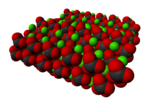 |
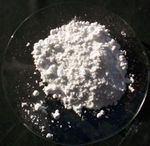 |
|
|
Calcium carbonate
|
|
| Identifiers | |
| CAS number | 471-34-1 |
| ChemSpider | 9708 |
| RTECS number | FF9335000 |
|
SMILES
[Ca+2].[O-]C([O-])=O
|
|
|
InChI
InChI=1/CH2O3.Ca/c2-1(3)4;/h(H2,2,3,4);/q;+2/p-2
Key: VTYYLEPIZMXCLO-NUQVWONBAS |
|
| Properties | |
| Molecular formula | CaCO3 |
| Exact mass | 100.0869 g/mol |
| Appearance | Fine white powder |
| Density | 2.71 g/cm3 (calcite) 2.83 g/cm3 (aragonite) |
| Melting point |
825 °C (calcite) |
| Boiling point |
decomposes |
| Solubility in water | 0.00015 mol/L (25°C) |
| Solubility product, Ksp | 4.8 × 10−9[1] |
| Solubility in dilute acids | soluble |
| Acidity (pKa) | 9.0 |
| Refractive index (nD) | 1.59 |
| Structure | |
| Crystal structure | Trigonal |
| Space group | 32/m |
| Hazards | |
| MSDS | ICSC 1193 |
| EU Index | Not listed |
| NFPA 704 |
 0
0
0
|
| Flash point | Non-flammable |
| Related compounds | |
| Other anions | Calcium bicarbonate |
| Other cations | Magnesium carbonate Strontium carbonate Barium carbonate |
| Related compounds | Calcium sulfate |
| Except where noted otherwise, data are given for materials in their standard state (at 25 °C, 100 kPa) |
|
| Infobox references | |
Calcium carbonate is a chemical compound with the chemical formula CaCO3. It is a common substance found in rock in all parts of the world, and is the main component of shells of marine organisms, snails, pearls, and eggshells. Calcium carbonate is the active ingredient in agricultural lime, and is usually the principal cause of hard water. It is commonly used medicinally as a calcium supplement or as an antacid, but excessive consumption can be hazardous.
Contents |
Chemical properties
Calcium carbonate shares the typical properties of other carbonates. Notably:
- it reacts with strong acids, releasing carbon dioxide:
- CaCO3(s) + 2 HCl(aq) → CaCl2(aq) + CO2(g) + H2O(l)
- it releases carbon dioxide on heating (to above 840 °C in the case of CaCO3), to form calcium oxide, commonly called quicklime, with reaction enthalpy 178 kJ / mole:
- CaCO3 → CaO + CO2
Calcium carbonate will react with water that is saturated with carbon dioxide to form the soluble calcium bicarbonate.
- CaCO3 + CO2 + H2O → Ca(HCO3)2
This reaction is important in the erosion of carbonate rocks, forming caverns, and leads to hard water in many regions.
Preparation
The vast majority of calcium carbonate used in industry is extracted by mining or quarrying. Pure calcium carbonate (e.g. for food or pharmaceutical use), can be produced from a pure quarried source (usually marble).
Alternatively, calcium carbonate is prepared by calcining crude calcium oxide. Water is added to give calcium hydroxide, and carbon dioxide is passed through this solution to precipitate the desired calcium carbonate, referred to in the industry as precipitated calcium carbonate (PCC):[2]
- CaCO3 → CaO + CO2
- CaO + H2O → Ca(OH)2
- Ca(OH)2 + CO2 → CaCO3 + H2O
Occurrence
Calcium carbonate is found naturally as the following minerals in the form of polymorphs:
- Aragonite
- Calcite
- Vaterite or (μ-CaCO3)
The trigonal crystal structure of calcite is most common.
The calcium carbonate minerals occur in the following rocks:
|
Geology
Carbonate is found frequently in geologic settings. It is found as a polymorph. A polymorph is a mineral with the same chemical formula but different chemical structure. Aragonite, calcite, limestone, chalk, marble, travertine, tufa, and others all have CaCO3 as their formula but each has a slightly different chemical structure. Calcite, as calcium carbonate is commonly referred to in geology is commonly talked about in marine settings. Calcite is typically found around the warm tropic environments. This is due to its chemistry and properties. Calcite is able to precipitate in warmer shallow environments than it does under colder environments because warmer environments do not favour the dissolution of CO2. This is analogous to CO2 being dissolved in soda. When you take the cap off of a soda bottle, the CO2 rushes out. As the soda warms up, carbon dioxide is released. This same principle can be applied to calcite in the ocean. Cold water carbonates do exist at higher latitudes but have a very slow growth rate.
In tropic settings, the waters are warm and clear. Consequently, you will see many more coral in this environment than you would towards the poles where the waters are cold. Calcium carbonate contributors such as corals, algae, and microorganisms are typically found in shallow water environments because as filter feeders they require sunlight to produce calcium carbonate.
Carbonate compensation depth
The carbonate compensation depth (CCD) is the point in the ocean where the rate of precipitation of calcium carbonate is balanced by the rate of dissolution due to the conditions present. Deep in the ocean, the temperature drops and pressure increases. Calcium carbonate is unusual in that its solubility increases with decreasing temperature. Increasing pressure also increases the solubility of calcium carbonate. The CCD can range from 4–6 km below sea level.
Uses
Industrial applications
The main use of calcium carbonate is in the construction industry, either as a building material in its own right (e.g. marble) or limestone aggregate for roadbuilding or as an ingredient of cement or as the starting material for the preparation of builder's lime by burning in a kiln.
Calcium carbonate is also used in the purification of iron from iron ore in a blast furnace. Calcium carbonate is calcined in situ to give calcium oxide, which forms a slag with various impurities present, and separates from the purified iron.[3]
Calcium carbonate is also used in the oil industry in drilling fluids as a formation bridging and filtercake sealing agent and may also be used as a weighting material to increase the density of drilling fluids to control downhole pressures.
Calcium carbonate is also one of the main sources used in growing Seacrete, or Biorock.
Precipitated calcium carbonate, pre-dispersed in slurry form, is also now widely used as filler material for latex gloves with the aim of achieving maximum saving in material and production costs.[4]
Calcium carbonate is widely used as an extender in paints,[5] in particular matte emulsion paint where typically 30% by weight of the paint is either chalk or marble.
Calcium carbonate is also widely used as a filler in plastics.[5] Some typical examples include around 15 to 20% loading of chalk in unplasticized polyvinyl chloride (uPVC) drain pipe, 5 to 15% loading of stearate coated chalk or marble in uPVC window profile. PVC cables can use calcium carbonate at loadings of up to 70 phr (parts per hundred parts of resin) to improve mechanical properties (tensile strength and elongation) and electrical properties (volume resistivity). Polypropylene compounds are often filled with calcium carbonate to increase rigidity, a requirement that becomes important at high use temperatures.[6] It also routinely used as a filler in thermosetting resins (Sheet and Bulk moulding compounds)[6] and has also been mixed with ABS, and other ingredients, to form some types of compression molded "clay" Poker chips.
Fine ground calcium carbonate is an essential ingredient in the microporous film used in babies' diapers and some building films as the pores are nucleated around the calcium carbonate particles during the manufacture of the film by biaxial stretching.
Calcium carbonate is also used in a wide range of trade and do it yourself adhesives, sealants, and decorating fillers.[5] Ceramic tile adhesives typically contain 70 to 80% limestone. Decorating crack fillers contain similar levels of marble or dolomite. It is also mixed with putty in setting stained glass windows, and as a resist to prevent glass from sticking to kiln shelves when firing glazes and paints at high temperature.
Calcium carbonate is known as whiting in ceramics/glazing applications,[5] where it is used as a common ingredient for many glazes in its white powdered form. When a glaze containing this material is fired in a kiln, the whiting acts as a flux material in the glaze.
Ground Calcium Carbonate (GCC) or Precipitated Calcium Carbonate (PCC) is used as a filler in paper. GCC and PCC are cheaper than wood fiber, so adding it to paper is cost efficient for the paper industry. Printing and writing paper can be made of 10 - 20% calcium cabonate.
In North America, calcium carbonate has begun to replace kaolin in the production of glossy paper. Europe has been practicing this as alkaline papermaking or acid-free papermaking for some decades. Carbonates are available in forms: ground calcium carbonate (GCC) or precipitated calcium carbonate (PCC). The latter has a very fine and controlled particle size, on the order of 2 micrometres in diameter, useful in coatings for paper.
It is used in swimming pools as a pH corrector for maintaining alkalinity "buffer" to offset the acidic properties of the disinfectant agent.
It is commonly called chalk as it has traditionally been a major component of blackboard chalk. Modern manufactured chalk is now mostly gypsum, hydrated calcium sulfate CaSO4·2H2O.
Ground calcium carbonate is further used as an abrasive (both as scouring powder and as an ingredient of household scouring creams), in particular in its calcite form, which has the relatively low hardness level of 3 on the Mohs scale of mineral hardness, and will therefore not scratch glass and most other ceramics, enamel, bronze, iron, and steel, and have a moderate effect on softer metals like aluminium and copper.
Health and dietary applications
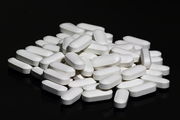
Calcium carbonate is widely used medicinally as an inexpensive dietary calcium supplement or gastric antacid.[7] It may be used as a phosphate binder for the treatment of hyperphosphatemia (primarily in patients with chronic renal failure). It is also used in the pharmaceutical industry as an inert filler for tablets and other pharmaceuticals.[8]
Calcium carbonate is used in the production of toothpaste and is also used in homeopathy as one of the constitutional remedies. Also, it has seen a resurgence as a food preservative and color retainer, when used in or with products such as organic apples or food[9].
Excess calcium from supplements, fortified food and high-calcium diets, can cause the "milk alkali syndrome," which has serious toxicity and can be fatal. In 1915, Bertram Sippy introduced the "Sippy regimen" of hourly ingestion of milk and cream, and the gradual addition of eggs and cooked cereal, for 10 days, combined with alkaline powders, which provided symptomatic relief for peptic ulcer disease. Over the next several decades, the Sippy regimen resulted in renal failure, alkalosis, and hypercalcemia, mostly in men with peptic ulcer disease. These adverse effects were reversed when the regimen stopped, but it was fatal in some patients with protracted vomiting. Milk alkali syndrome declined in men after effective treatments for peptic ulcer disease. During the past 15 years, it has been reported in women taking calcium supplements above the recommended range of 1.2 to 1.5 g daily, for prevention and treatment of osteoporosis, and is exacerbated by dehydration. Calcium has been added to over-the-counter products, which contributes to inadvertent excessive intake. Excessive calcium intake can lead to hypercalcemia, complications of which include vomiting, abdominal pain and altered mental status.[10]
As a food additive it is designated E170.[11] It is used in some soy milk products as a source of dietary calcium; one study suggests that calcium carbonate might be as bioavailable as the calcium in cow's milk.[12] Calcium carbonate is also used as a firming agent in many canned or bottled vegetable products.
Environmental applications
In 1989, a researcher, Ken Simmons, introduced CaCO3 into the Whetstone Brook in Massachusetts.[13] His hope was that the calcium carbonate would counter the acid in the stream from acid rain and save the trout that had ceased to spawn. Although his experiment was a success, it did increase the amounts of aluminium ions in the area of the brook that was not treated with the limestone. This shows that CaCO3 can be added to neutralize the effects of acid rain in river ecosystems. Currently calcium carbonate is used to neutralize acidic conditions in both soil and water.[14][15]. Since the 1970s, such liming has been practiced on a large scale in Sweden to mitigate acidification and several thousand lakes and streams are limed repeatedly.[16]
Calcination equilibrium
Calcination of limestone using charcoal fires to produce quicklime has been practiced since antiquity by cultures all over the world. The temperature at which limestone yields calcium oxide is usually given as 825 °C, but stating an absolute threshold is misleading. Calcium carbonate exists in equilibrium with calcium oxide and carbon dioxide at any temperature. At each temperature there is a partial pressure of carbon dioxide that is in equilibrium with calcium carbonate. At room temperature the equilibrium overwhelmingly favors calcium carbonate, because the equilibrium CO2 pressure is only a tiny fraction of the partial CO2 pressure in air, which is about 0.035 kPa.
At temperatures above 550 °C the equilibrium CO2 pressure begins to exceed the CO2 pressure in air. So above 550 °C, calcium carbonate begins to outgas CO2 into air. But in a charcoal fired kiln, the concentration of CO2 will be much higher than it is in air. Indeed if all the oxygen in the kiln is consumed in the fire, then the partial pressure of CO2 in the kiln can be as high as 20 kPa.
The table shows that this equilibrium pressure is not achieved until the temperature is nearly 800 °C. For the outgassing of CO2 from calcium carbonate to happen at an economically useful rate, the equilibrium pressure must significantly exceed the ambient pressure of CO2. And for it to happen rapidly, the equilibrium pressure must exceed total atmospheric pressure of 101 kPa, which happens at 898 °C.
| Equilibrium pressure of CO2 over CaCO3 (P) vs temperature (T).[17] | |||||||||||||||||
|---|---|---|---|---|---|---|---|---|---|---|---|---|---|---|---|---|---|
| P (kPa) | 0.055 | 0.13 | 0.31 | 1.80 | 5.9 | 9.3 | 14 | 24 | 34 | 51 | 72 | 80 | 91 | 101 | 179 | 901 | 3961 |
| T (°C) | 550 | 587 | 605 | 680 | 727 | 748 | 777 | 800 | 830 | 852 | 871 | 881 | 891 | 898 | 937 | 1082 | 1241 |
Solubility
With varying CO2 pressure
| Calcium ion solubility as a function of CO2 partial pressure at 25 °C (Ksp = 4.47×10−9) |
||
|---|---|---|
 (atm) (atm) |
pH | [Ca2+] (mol/L) |
| 10−12 | 12.0 | 5.19 × 10−3 |
| 10−10 | 11.3 | 1.12 × 10−3 |
| 10−8 | 10.7 | 2.55 × 10−4 |
| 10−6 | 9.83 | 1.20 × 10−4 |
| 10−4 | 8.62 | 3.16 × 10−4 |
| 3.5 × 10−4 | 8.27 | 4.70 × 10−4 |
| 10−3 | 7.96 | 6.62 × 10−4 |
| 10−2 | 7.30 | 1.42 × 10−3 |
| 10−1 | 6.63 | 3.05 × 10−3 |
| 1 | 5.96 | 6.58 × 10−3 |
| 10 | 5.30 | 1.42 × 10−2 |
Calcium carbonate is poorly soluble in pure water (47 mg/L at normal atmospheric CO2 partial pressure as shown below).
The equilibrium of its solution is given by the equation (with dissolved calcium carbonate on the right):
-
CaCO3  Ca2+ + CO32–
Ca2+ + CO32–Ksp = 3.7×10−9 to 8.7×10−9 at 25 °C
where the solubility product for [Ca2+][CO32–] is given as anywhere from Ksp = 3.7×10−9 to Ksp = 8.7×10−9 at 25 °C, depending upon the data source.[17][18] What the equation means is that the product of molar concentration of calcium ions (moles of dissolved Ca2+ per liter of solution) with the molar concentration of dissolved CO32– cannot exceed the value of Ksp. This seemingly simple solubility equation, however, must be taken along with the more complicated equilibrium of carbon dioxide with water (see carbonic acid). Some of the CO32– combines with H+ in the solution according to:
-
HCO3–  H+ + CO32–
H+ + CO32– Ka2 = 5.61×10−11 at 25 °C
HCO3– is known as the bicarbonate ion. Calcium bicarbonate is many times more soluble in water than calcium carbonate—indeed it exists only in solution.
Some of the HCO3– combines with H+ in solution according to:
-
H2CO3  H+ + HCO3–
H+ + HCO3– Ka1 = 2.5×10−4 at 25 °C
Some of the H2CO3 breaks up into water and dissolved carbon dioxide according to:
-
H2O + CO2(dissolved)  H2CO3
H2CO3 Kh = 1.70×10−3 at 25 °C
And dissolved carbon dioxide is in equilibrium with atmospheric carbon dioxide according to:
-
![\frac{P_{\text{CO}_2}}{[\text{CO}_2]}\ =\ k_\text{H}](/I/f676f5c92fcbd2c48e1f0c1770610db9.png)
where kH = 29.76 atm/(mol/L) at 25 °C (Henry constant),  being the CO2 partial pressure.
being the CO2 partial pressure.
For ambient air,  is around 3.5×10−4 atmospheres (or equivalently 35 Pa). The last equation above fixes the concentration of dissolved CO2 as a function of
is around 3.5×10−4 atmospheres (or equivalently 35 Pa). The last equation above fixes the concentration of dissolved CO2 as a function of  , independent of the concentration of dissolved CaCO3. At atmospheric partial pressure of CO2, dissolved CO2 concentration is 1.2×10–5 moles/liter. The equation before that fixes the concentration of H2CO3 as a function of [CO2]. For [CO2]=1.2×10–5, it results in [H2CO3]=2.0×10−8 moles per liter. When [H2CO3] is known, the remaining three equations together with
, independent of the concentration of dissolved CaCO3. At atmospheric partial pressure of CO2, dissolved CO2 concentration is 1.2×10–5 moles/liter. The equation before that fixes the concentration of H2CO3 as a function of [CO2]. For [CO2]=1.2×10–5, it results in [H2CO3]=2.0×10−8 moles per liter. When [H2CO3] is known, the remaining three equations together with
-
H2O  H+ + OH–
H+ + OH–K = 10−14 at 25 °C
(which is true for all aqueous solutions), and the fact that the solution must be electrically neutral,
- 2[Ca2+] + [H+] = [HCO3–] + 2[CO32–] + [OH–]
make it possible to solve simultaneously for the remaining five unknown concentrations (note that the above form of the neutrality equation is valid only if calcium carbonate has been put in contact with pure water or with a neutral pH solution; in the case where the origin water solvent pH is not neutral, the equation is modified).

The table on the right shows the result for [Ca2+] and [H+] (in the form of pH) as a function of ambient partial pressure of CO2 (Ksp = 4.47×10−9 has been taken for the calculation).
- At atmospheric levels of ambient CO2 the table indicates the solution will be slightly alkaline with a maximum CaCO3 solubility of 47 mg/L.
- As ambient CO2 partial pressure is reduced below atmospheric levels, the solution becomes more and more alkaline. At extremely low
 , dissolved CO2, bicarbonate ion, and carbonate ion largely evaporate from the solution, leaving a highly alkaline solution of calcium hydroxide, which is more soluble than CaCO3. Note that for
, dissolved CO2, bicarbonate ion, and carbonate ion largely evaporate from the solution, leaving a highly alkaline solution of calcium hydroxide, which is more soluble than CaCO3. Note that for  = 10−12 atm, the [Ca2+][OH-]2 product is still below the solubility product of Ca(OH)2 (8×10−6). For still lower CO2 pressure, Ca(OH)2 precipitation will occur before CaCO3 precipitation.
= 10−12 atm, the [Ca2+][OH-]2 product is still below the solubility product of Ca(OH)2 (8×10−6). For still lower CO2 pressure, Ca(OH)2 precipitation will occur before CaCO3 precipitation.
- As ambient CO2 partial pressure increases to levels above atmospheric, pH drops, and much of the carbonate ion is converted to bicarbonate ion, which results in higher solubility of Ca2+.
The effect of the latter is especially evident in day to day life of people who have hard water. Water in aquifers underground can be exposed to levels of CO2 much higher than atmospheric. As such water percolates through calcium carbonate rock, the CaCO3 dissolves according to the second trend. When that same water then emerges from the tap, in time it comes into equilibrium with CO2 levels in the air by outgassing its excess CO2. The calcium carbonate becomes less soluble as a result and the excess precipitates as lime scale. This same process is responsible for the formation of stalactites and stalagmites in limestone caves.
Two hydrated phases of calcium carbonate, monohydrocalcite, CaCO3·H2O and ikaite, CaCO3·6H2O, may precipitate from water at ambient conditions and persist as metastable phases.
With varying pH
We now consider the problem of the maximum solubility of calcium carbonate in normal atmospheric conditions ( = 3.5 × 10−4 atm) when the pH of the solution is adjusted. This is for example the case in a swimming pool where the pH is maintained between 7 and 8 (by addition of sodium bisulfate NaHSO4 to decrease the pH or of sodium bicarbonate NaHCO3 to increase it). From the above equations for the solubility product, the hydration reaction and the two acid reactions, the following expression for the maximum [Ca2+] can be easily deduced:
= 3.5 × 10−4 atm) when the pH of the solution is adjusted. This is for example the case in a swimming pool where the pH is maintained between 7 and 8 (by addition of sodium bisulfate NaHSO4 to decrease the pH or of sodium bicarbonate NaHCO3 to increase it). From the above equations for the solubility product, the hydration reaction and the two acid reactions, the following expression for the maximum [Ca2+] can be easily deduced:
showing a quadratic dependence in [H+]. The numerical application with the above values of the constants gives
| pH | 7.0 | 7.2 | 7.4 | 7.6 | 7.8 | 8.0 | 8.2 | 8.27 | 8.4 | |
| [Ca2+]max (10−6mol/L) | 180 | 71.7 | 28.5 | 11.4 | 4.52 | 1.80 | 0.717 | 0.519 | 0.285 | |
| [Ca2+]max (mg/L) | 7.21 | 2.87 | 1.14 | 0.455 | 0.181 | 0.0721 | 0.0287 | 0.0208 | 0.0114 | |
Comments:
- decreasing the pH from 8 to 7 increases the maximum Ca2+ concentration by a factor 100. Water with a pH maintained to 7 can dissolve up to 15.9 g/L of CaCO3. This explains the high Ca2+ concentration in some mineral waters with pH close to 7.
- note that the Ca2+ concentration of the previous table is recovered for pH = 8.27
- keeping the pH to 7.4 in a swimming pool (which gives optimum HClO/ClO− ratio in the case of "chlorine" maintenance) results in a maximum Ca2+ concentration of 1010 mg/L. This means that successive cycles of water evaporation and partial renewing may result in a very hard water before CaCO3 precipitates (water with a Ca2+ concentration above 120 mg/L is considered very hard). Addition of a calcium sequestring agent or complete renewing of the water will solve the problem.
Solubility in a strong or weak acid solution
Solutions of strong (HCl), moderately strong (sulfamic) or weak (acetic, citric, sorbic, lactic, phosphoric) acids are commercially available. They are commonly used as descaling agents to remove limescale deposits. The maximum amount of CaCO3 that can be "dissolved" by one liter of an acid solution can be calculated using the above equilibrium equations.
- In the case of a strong monoacid with decreasing acid concentration [A] = [A-], we obtain (with CaCO3 molar mass = 100 g):
| [A] (mol/L) | 1 | 10−1 | 10−2 | 10−3 | 10−4 | 10−5 | 10−6 | 10−7 | 10−10 | |
| Initial pH | 0.00 | 1.00 | 2.00 | 3.00 | 4.00 | 5.00 | 6.00 | 6.79 | 7.00 | |
| Final pH | 6.75 | 7.25 | 7.75 | 8.14 | 8.25 | 8.26 | 8.26 | 8.26 | 8.27 | |
| Dissolved CaCO3 (g per liter of acid) | 50.0 | 5.00 | 0.514 | 0.0849 | 0.0504 | 0.0474 | 0.0471 | 0.0470 | 0.0470 | |
where the initial state is the acid solution with no Ca2+ (not taking into account possible CO2 dissolution) and the final state is the solution with saturated Ca2+. For strong acid concentrations, all species have a negligible concentration in the final state with respect to Ca2+ and A- so that the neutrality equation reduces approximately to 2[Ca2+] = [A-] yielding ![\scriptstyle[\mathrm{Ca}^{2+}] \simeq \frac{[\mathrm{A}^-]}{2}](/I/be27098c6038ef4b45348e8acc57825e.png) . When the concentration decreases, [HCO3-] becomes non negligible so that the preceding expression is no longer valid. For vanishing acid concentrations, we recover the final pH and the solubility of CaCO3 in pure water.
. When the concentration decreases, [HCO3-] becomes non negligible so that the preceding expression is no longer valid. For vanishing acid concentrations, we recover the final pH and the solubility of CaCO3 in pure water.
- In the case of a weak monoacid (here we take acetic acid with pKA = 4.76) with decreasing total acid concentration [A] = [A-]+[AH], we obtain:
| [A] (mol/L) | 1 | 10−1 | 10−2 | 10−3 | 10−4 | 10−5 | 10−6 | 10−7 | 10−10 | |
| Initial pH | 2.38 | 2.88 | 3.39 | 3.91 | 4.47 | 5.15 | 6.02 | 6.79 | 7.00 | |
| Final pH | 6.75 | 7.25 | 7.75 | 8.14 | 8.25 | 8.26 | 8.26 | 8.26 | 8.27 | |
| Dissolved CaCO3 (g per liter of acid) | 49.5 | 4.99 | 0.513 | 0.0848 | 0.0504 | 0.0474 | 0.0471 | 0.0470 | 0.0470 | |
We see that for the same total acid concentration, the initial pH of the weak acid is less acid than the one of the strong acid; however, the maximum amount of CaCO3 which can be dissolved is approximately the same. This is because in the final state, the pH is larger than the pKA, so that the weak acid is almost completely dissociated, yielding in the end as many H+ ions as the strong acid to "dissolve" the calcium carbonate.
- The calculation in the case of phosphoric acid (which is the most widely used for domestic applications) is more complicated since the concentrations of the four dissociation states corresponding to this acid must be calculated together with [HCO3-], [CO32-], [Ca2+], [H+] and [OH-]. The system may be reduced to a seventh degree equation for [H+] the numerical solution of which gives
| [A] (mol/L) | 1 | 10−1 | 10−2 | 10−3 | 10−4 | 10−5 | 10−6 | 10−7 | 10−10 | |
| Initial pH | 1.08 | 1.62 | 2.25 | 3.05 | 4.01 | 5.00 | 5.97 | 6.74 | 7.00 | |
| Final pH | 6.71 | 7.17 | 7.63 | 8.06 | 8.24 | 8.26 | 8.26 | 8.26 | 8.27 | |
| Dissolved CaCO3 (g per liter of acid) | 62.0 | 7.39 | 0.874 | 0.123 | 0.0536 | 0.0477 | 0.0471 | 0.0471 | 0.0470 | |
where [A] = [H3PO4] + [H2PO4-] + [HPO42-] + [PO43-] is the total acid concentration. We see that phosphoric acid is more efficient than a monoacid since at the final almost neutral pH, the second dissociated state concentration [HPO42-] is not negligible (see phosphoric acid).
See also
- Cuttlebone
- Cuttlefish
- Gesso
- Limescale
- Marble
- Ocean acidification
References
- ↑ Patnaik, Pradyot (2003). Handbook of Inorganic Chemical Compounds. McGraw-Hill. ISBN 0070494398. http://books.google.com/?id=Xqj-TTzkvTEC. Retrieved 2009-06-06.
- ↑ "Solvay Precipitated Calcium Carbonate: Production". Solvay S. A.. 2007-03-09. http://www.solvaypcc.com/safety_environment/0,0,1000044-_EN,00.html. Retrieved 2007-12-30.
- ↑ "Blast Furnace". Science Aid. http://www.scienceaid.co.uk/chemistry/industrial/blastfurnace.html. Retrieved 2007-12-30.
- ↑ "Precipitated Calcium Carbonate uses". http://www.aristocratholding.com/calris-5.html.
- ↑ 5.0 5.1 5.2 5.3 "Calcium Carbonate Powder". Reade Advanced Materials. 2006-02-04. http://www.reade.com/Products/Minerals_and_Ores/calcium_carbonate.html. Retrieved 2007-12-30.
- ↑ 6.0 6.1 "Calcium carbonate in plastic applications". Imerys Performance Minerals. http://www.imerys-perfmins.com/calcium-carbonate/eu/calcium-carbonate-plastic.htm. Retrieved 2008-08-01.
- ↑ "Calcium Carbonate". Medline Plus. National Institutes of Health. 2005-10-01. http://www.nlm.nih.gov/medlineplus/druginfo/medmaster/a601032.html. Retrieved 2007-12-30.
- ↑ Herbert A. Lieberman, Leon Lachman, Joseph B. Schwartz (1990). Pharmaceutical Dosage Forms: Tablets. New York: Dekker. p. 153. ISBN 0824780442.
- ↑ http://chemistry.about.com/od/foodcookingchemistry/a/cadditives.htm
- ↑ Ilan Gabriely et al. (2008). "Clinical problem-solving, back to basics". New England Journal of Medicine 358 (18): 1952. doi:10.1056/NEJMcps0706188. PMID 18450607. http://content.nejm.org/cgi/content/short/358/18/1952.
- ↑ "Food-Info.net : E-numbers : E170 Calcium carbonate". http://www.food-info.net/uk/e/e170.htm. 080419 food-info.net
- ↑ Y. Zhao, B. R. Martin and C. M. Weaver (2005). "Calcium Bioavailability of Calcium Carbonate Fortified Soymilk Is Equivalent to Cow's Milk in Young Women". J. Nutr. 135 (10): 2379–2382. PMID 16177199.
- ↑ Associated Press (1989-06-13). "Limestone Dispenser Fights Acid Rain in Stream". New York Times. http://query.nytimes.com/gst/fullpage.html?res=950DEFD9173FF930A25755C0A96F948260.
- ↑ R. K. Schreiber (1988). "Cooperative federal-state liming research on surface waters impacted by acidic deposition". Water, Air, & Soil Pollution 41 (1): 53–73. http://www.springerlink.com/content/x71m4r306055p651/.
- ↑ Dan Kircheis; Richard Dill (2006). "Effects of low pH and high aluminum on Atlantic salmon smolts in Eastern Maine and liming project feasibility analysis" (reprinted at Downeast Salmon Federation). National Marine Fisheries Service and Maine Atlantic Salmon Commission. http://www.mainesalmonrivers.org/pages/Liming%20Project%20Rpt.pdf.
- ↑ M. Guhren, C. Bigler and I. Renberg (2007). "Liming placed in a long-term perspective: A paleolimnological study of 12 lakes in the Swedish liming program". Journal of Paleolimnology 37: 247–258. doi:10.1007/s10933-006-9014-9.
- ↑ 17.0 17.1 Lide, D. R., ed. (2005), CRC Handbook of Chemistry and Physics (86th ed.), Boca Raton (FL): CRC Press, ISBN 0-8493-0486-5
- ↑ "Selected Solubility Products and Formation Constants at 25 °C". California State University, Dominguez Hills. http://www.csudh.edu/oliver/chemdata/data-ksp.htm.
External links
- International Chemical Safety Card 1193
- CID 516889 from PubChem
- ATC codes: A02AC01 and A12AA04
- The British Calcium Carbonate Association – What is calcium carbonate
|
|||||
|
||||||||||||||||||||||||||

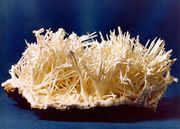
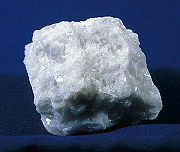
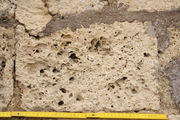
![[\text{Ca}^{2+}]_\text{max} = \frac{K_\text{sp}} {K_\text{h}K_\text{a1}K_\text{a2}k_\text{H}} \frac{[\text{H}^+]^2}{P_{\text{CO}_2}}](/I/a836ad7dcb0f3a5cd069564f0de4821b.png)